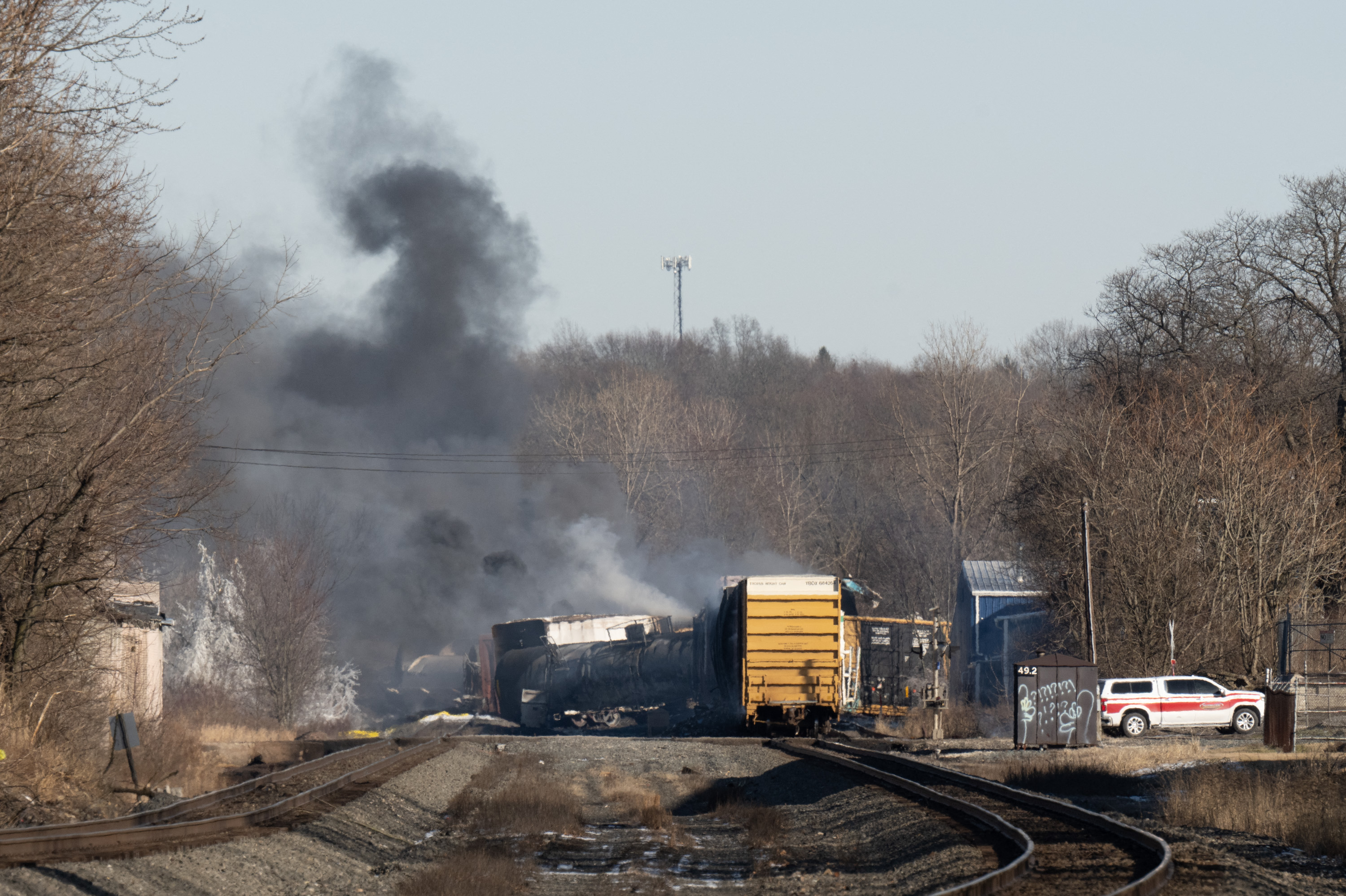Ohio Train Derailment: Investigation Into Lingering Toxic Chemicals In Nearby Structures

Table of Contents
The Initial Impact and Subsequent Concerns
The derailment of a Norfolk Southern freight train carrying hazardous materials resulted in the release of a cocktail of toxic chemicals, including vinyl chloride, butyl acrylate, and ethylhexyl acrylate. The immediate consequences were dramatic:
- Timeline: The derailment occurred on February 3rd. Controlled burns of vinyl chloride commenced on February 6th, releasing toxic fumes into the air. Evacuation orders were issued for a 1-mile radius around the crash site.
- Chemicals Released: The sheer quantity and toxicity of the released chemicals are alarming. Vinyl chloride, a known carcinogen, was a primary concern. Butyl acrylate and ethylhexyl acrylate, both irritants, added to the environmental hazard.
- Immediate Health Impacts: Residents reported symptoms including headaches, nausea, respiratory irritation, and skin rashes. The immediate impact on air and water quality was significant, causing widespread concern.
- Initial Cleanup Efforts: Initial cleanup efforts focused on containing the immediate spill and preventing further release of chemicals. However, questions remain about the long-term efficacy of these initial measures.
Investigating Lingering Contamination in Nearby Structures
Concerns remain about the potential for lingering contamination in homes, businesses, and the surrounding environment. Investigations are underway to assess the extent of the contamination:
- Testing Methods: Soil samples are being analyzed for the presence of various chemicals. Water sources are undergoing rigorous testing to detect contamination. Air quality monitoring is also being conducted to assess the presence of volatile organic compounds.
- Locations Investigated: Testing is not only limited to the immediate vicinity of the derailment but also extends to residential areas and businesses further afield. The extent of the contamination plume is still being determined.
- Preliminary Findings: While comprehensive results are still pending, preliminary findings have revealed detectable levels of contaminants in some areas. The long-term implications of these findings are currently under evaluation.
- Challenges of Detection: Detecting and measuring low levels of lingering contamination in diverse building materials poses significant analytical challenges. Advanced techniques are being deployed to ensure accurate assessments.
Potential Long-Term Health Effects of Exposure
Exposure to the released chemicals poses significant long-term health risks to the residents of East Palestine and surrounding communities:
- Known Health Risks: Vinyl chloride is a known human carcinogen linked to liver cancer, brain cancer, and lung cancer. Butyl acrylate and ethylhexyl acrylate can cause respiratory problems, skin irritation, and eye irritation.
- Ongoing Health Monitoring: Health monitoring programs have been established to track the health of affected residents. Longitudinal studies are crucial to assess the long-term impact of exposure.
- Need for Long-Term Studies: The long-term health consequences of exposure to this complex mixture of chemicals require extensive, long-term epidemiological studies. These studies are essential to fully understand the delayed health effects.
- Cancer Risk: The carcinogenic nature of vinyl chloride raises serious concerns about potential increases in cancer incidence in the affected population over the coming years and decades.
The Ongoing Cleanup and Remediation Efforts
The cleanup and remediation efforts are ongoing and face significant challenges:
- Cleanup Techniques: Contaminated soil and water are being removed and treated. The specific techniques employed depend on the nature and extent of contamination.
- Challenges in Cleanup: The complexity of the contamination, the sheer volume of affected material, and the need for meticulous handling present significant challenges.
- Regulatory Oversight: The Environmental Protection Agency (EPA) and other regulatory agencies are overseeing the cleanup process to ensure it adheres to safety standards.
- Community Involvement: Community involvement and transparency are crucial to address resident concerns and build trust. Open communication and community engagement are essential throughout the remediation process.
Conclusion
The Ohio train derailment and the subsequent release of toxic chemicals pose a significant and ongoing threat to the health and environment of East Palestine and surrounding areas. The potential for lingering contamination in structures and the long-term health effects of exposure necessitate thorough investigation, comprehensive cleanup, and robust long-term health monitoring. Transparency and accountability from responsible parties are paramount. Stay informed about the ongoing investigation into the Ohio train derailment and the lingering threat of toxic chemicals. Follow reputable news sources, participate in community efforts to ensure a safe and healthy environment, and demand accountability and transparency in the cleanup process. If you experience any health problems, seek medical advice and report any concerns to the appropriate authorities. Understanding the lingering effects of this disaster is crucial for the health and well-being of the community.

Featured Posts
-
 Analyse Bfm Bourse Informations Cles Du 17 Fevrier 15h Et 16h
Apr 23, 2025
Analyse Bfm Bourse Informations Cles Du 17 Fevrier 15h Et 16h
Apr 23, 2025 -
 Goldman Ceo Pay Battle Banker Vs Private Equity Executive
Apr 23, 2025
Goldman Ceo Pay Battle Banker Vs Private Equity Executive
Apr 23, 2025 -
 Jackson Chourios Two Home Runs Power Brewers 8 2 Victory Over Reds
Apr 23, 2025
Jackson Chourios Two Home Runs Power Brewers 8 2 Victory Over Reds
Apr 23, 2025 -
 Boeings 5 6 Billion Jeppesen Sale To Thoma Bravo A Deep Dive
Apr 23, 2025
Boeings 5 6 Billion Jeppesen Sale To Thoma Bravo A Deep Dive
Apr 23, 2025 -
 Ser Alktkwt Alywm Alathnyn 14 Abryl 2025 Msr
Apr 23, 2025
Ser Alktkwt Alywm Alathnyn 14 Abryl 2025 Msr
Apr 23, 2025
